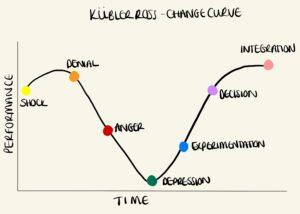Navigating change is an inevitable part of running a business. And, with the new government announcing their budget this week business owners I have spoken with are all talking about what impact this might have and what changes they might need to make. There is no doubt that change can be daunting but with the right mindset, tools and strategies there are ways to adapt and thrive when unexpected change occurs.
We’ve all been there through the pandemic when change came upon us very quickly and I have seen more resilience in business owners since then but when change isn’t born out of your own choice it can still be hard to navigate.
In my blog today, I am going to share some of things that you can use to prepare for and work through change using frameworks like the Formula for Change and the Change Curve.
Understanding the Formula for Change
Brad Sugars developed the Formula for Change to help leaders understand the elements needed to drive meaningful change and it is something that I talk to clients about a lot. It looks like this:
D x V + F > R
This formula suggests that for change to occur, three factors must outweigh resistance:
- Dissatisfaction (D) – There must be a strong reason to change. If you or your team are content with the status quo, there will be little incentive to move forward. Dissatisfaction creates urgency.
- Vision (V) – A clear and compelling vision provides direction. People need to know where they’re headed and why it matters. The stronger the vision, the more motivation there is to pursue it.
- First Steps (F) – Even the most compelling vision needs concrete steps to kick-start the process. First steps create momentum, turning abstract ideas into actionable plans.
When these factors are strong enough, they can overcome resistance (R), allowing meaningful change to occur. Business owners can use this formula to create a solid foundation for implementing change in a way that’s intentional and well-supported.
Applying the Change Curve
The Change Curve, based on the Kübler-Ross model, highlights the emotional journey people often experience when facing change. It consists of several stages:

- Shock – The first reaction to change is often shock or surprise, especially if the change is sudden. This stage can bring a sense of disbelief, which can leave people feeling unprepared or hesitant to act. As business leaders, it’s important to provide reassurance during this phase, even if immediate answers aren’t available.
- Denial – After the initial shock, it’s common for people to enter a stage of denial. At this point, individuals may question the necessity or validity of the change, leading to resistance or attempts to return to familiar routines. Clear and consistent communication about the reasons for change can help overcome this resistance and lay the groundwork for moving forward.
- Frustration – As the reality of change sinks in, frustration or anger may emerge. People might focus on what is being lost or disrupted, which can create tension or disengagement. Acknowledging these feelings is essential, as is keeping the focus on the potential benefits and new opportunities that change can bring. This is also a good time to address specific concerns and reiterate the support available.
- Experimentation – Gradually, individuals begin to adapt to the new reality. This stage, often marked by experimentation and small wins, allows people to test out new approaches or ideas related to the change. Encouraging experimentation can help team members feel more engaged and involved in the process, increasing buy-in and reducing lingering resistance.
- Decision – By this stage, team members are beginning to embrace the change more fully. They recognise the benefits, understand how to work within the new environment, and start seeing how it aligns with both personal and business goals. Reinforcing the positive aspects of the transition and celebrating progress can strengthen commitment at this stage.
- Integration – Finally, the change becomes part of the “new normal,” and it’s integrated into daily operations and mindsets. At this point, the team is fully adapted, and the change is no longer perceived as a disruption but as part of the business’s structure. Recognising and celebrating the transition to integration is crucial, as it not only rewards the team’s resilience but also sets a positive precedent for future changes.
Understanding the Change Curve can help business owners empathise with their team’s reactions, and it provides a framework to guide them through each phase. By preparing for the stages, you can effectively support yourself and your team, creating smoother transitions and better long-term outcomes.
Overcoming Unexpected Changes
Not all change can be planned. Sometimes, circumstances shift overnight, requiring immediate action. Here’s how to respond effectively when facing the unexpected:
- Assess the Situation: Take a moment to fully understand the change and its potential impact. A rushed response can lead to mistakes. Instead, evaluate your options, even if time is limited, and identify both immediate and long-term priorities.
- Engage Your Team: Communication is critical during times of unexpected change. Keep your team informed, share your vision for moving forward, and involve them in creating solutions. Teams that feel included are more committed to the process and less likely to resist.
- Stay Focused on Your Vision: Sudden changes can cause business owners to lose sight of their goals. During turbulent times, it’s essential to keep your vision front and centre. Remind yourself and your team of your mission and how it can guide you through new challenges.
- Rely on Small Wins for Momentum: In the face of big changes, break down your response into small, actionable steps. These small wins not only build morale but also help you maintain momentum and create progress, even if it’s gradual.
Business owners who are willing to invest in support and systems, both for times of growth and for times of change, often see not only improved results but also greater resilience. Change can be a powerful growth opportunity when approached with the right mindset and preparation. When you incorporate these strategies, you’re not just surviving change—you’re using it to fuel your business forward.





